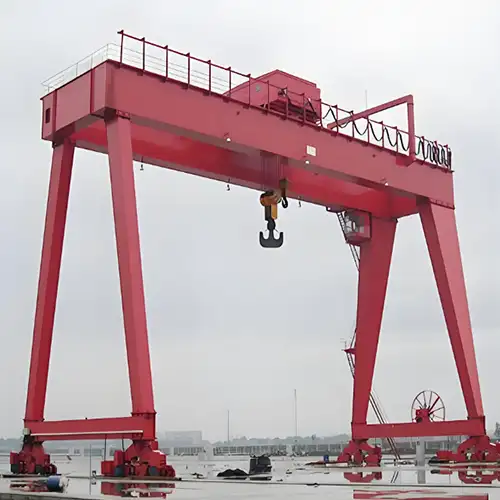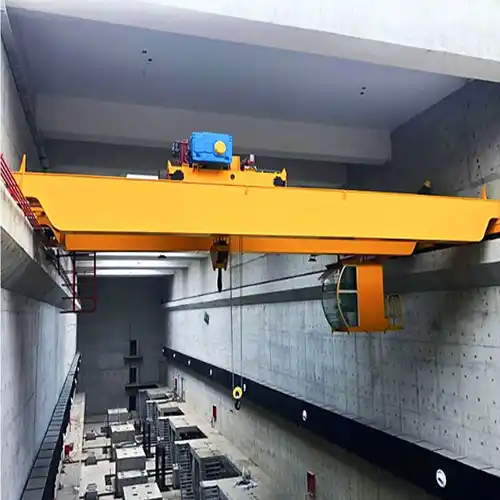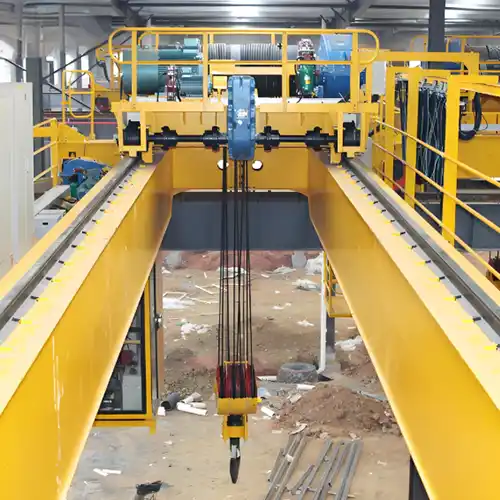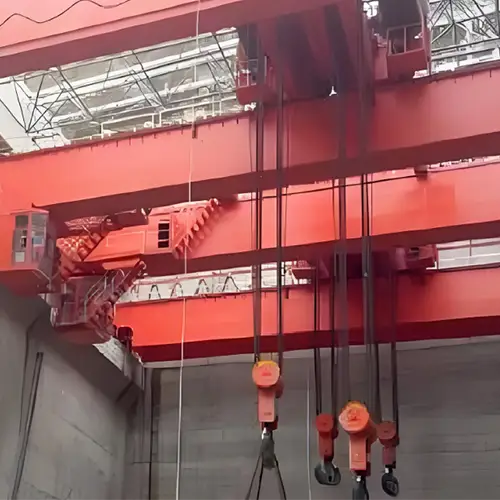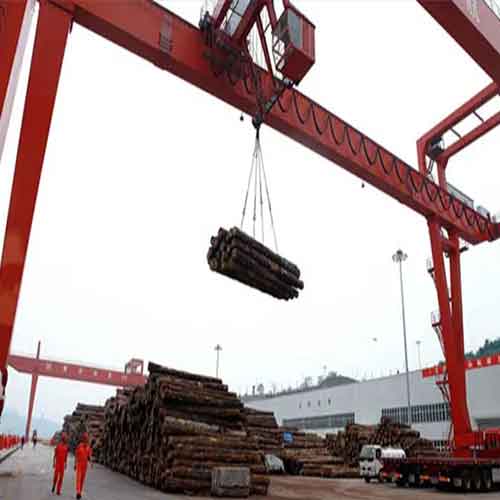Heavy Duty Gantry Cranes: Engineering Solutions for Heavy Industrial Material Handling
Heavy-duty gantry cranes offer powerful, customized lifting solutions for heavy industries, ensuring efficiency, safety, and tailored performance for demanding applications
| Crane type | Heavy Duty Gantry Crane |
| Crane capacity | 3 to 550 ton |
| Lifting height | As your request |
| Crane span | As your request |
Category: Heavy Duty & Large Capacity
Your Trusted Heavy Duty Gantry Crane Manufacturer & Supplier
Heavy Duty Gantry Cranes, Engineered for Heavy Material Handling
Customized Heavy Duty Crane for Sale, Affordable Industrial Gantry Cranes for Your Needs
Basics of Heavy Duty Gantry Cranes
Heavy duty gantry cranes are robust lifting machines designed to handle substantial loads in various industrial settings. These cranes typically consist of a bridge supported by two or more legs that move on fixed tracks or wheels. They are engineered for heavy lifting tasks, capable of handling loads ranging from 20 tons to over 500 tons. Their versatile design allows them to lift and transport large items, such as steel beams, containers, and heavy machinery, making them essential in sectors that require reliable and efficient lifting solutions.
Heavy duty gantry cranes play a crucial role in many industrial applications, where safety and efficiency are paramount. They are extensively used in manufacturing, construction, shipbuilding, and steel fabrication. By providing a reliable means to lift and move heavy materials, these cranes enhance productivity and reduce manual labor risks. Their ability to operate in confined spaces and handle various load sizes makes them indispensable in complex industrial environments. Additionally, heavy duty gantry cranes contribute to streamlined workflows, minimizing downtime during critical operations.
Main Types of Heavy Duty Gantry Cranes and Their Typical Features
Heavy duty gantry cranes are classified based on their design and intended applications. Here are the primary types, emphasizing their robust

Rail Mounted Gantry (RMG) Crane
Features:
- Mobility: Designed to move along rails, providing precise positioning for heavy loads.
- Capacity: Engineered to handle significant loads, typically ranging from 20 tons to over 500 tons.
- Span and Height: Offers customizable spans (often exceeding 30m) and lifting heights to accommodate various container dimensions.
- Applications: Primarily utilized in railway yards for efficient container handling.

Rubber Tyred Gantry (RTG) Crane
Features:
- Mobility: Fitted with rubber tires, allowing for flexibility and maneuverability on uneven surfaces.
- Versatility: Easily navigates busy container terminals and precast yards, making it adaptable to different environments.
- Capacity: Generally supports loads from 20 tons to over 100 tons, suitable for heavy-duty tasks.
- Applications: Ideal for use in the precast concrete and logistics industries.

Features:
- Stability: Provides enhanced stability thanks to its robust double girder design.
- High Load Capacity: Capable of supporting heavier loads, often exceeding 200 tons.
- Span and Height: Features wider spans and greater lifting heights compared to single girder models.
- Applications: Commonly employed in steel plants and heavy manufacturing settings.

Features:
- Lightweight Design: Generally lighter than double girder cranes, making them more cost-effective for lighter loads.
- Capacity: Typically handles loads ranging from 20 to 50 tons, suitable for various applications.
- Compact Size: Requires less installation space, making it ideal for facilities with spatial constraints.
- Applications: Best suited for smaller manufacturing facilities and warehouses where heavy-duty design is not as critical.

Features:
- Hybrid Design: Integrates features of both gantry and overhead cranes, with one end supported by a structure for added strength.
- Flexibility: Capable of operating in confined spaces while still managing heavy loads.
- Capacity: Handles moderate loads ranging from 20 tons to 50 tons, offering versatility in various operations.
- Applications: Frequently used in manufacturing and assembly processes where heavy-duty capabilities are required but spatial constraints exist.
Selecting the right type of heavy duty gantry crane is crucial for ensuring efficiency and safety in operations across diverse industries. Each crane type is designed with specific features to meet the demands of heavy lifting, making them essential tools in logistics, manufacturing, construction, and more.
Key Features of Heavy Duty Gantry Cranes
Load Capacity and Span
- Typical Capacities (20-500 tons): Heavy duty gantry cranes are designed to handle a wide range of load capacities, typically between 20 to 500 tons. This extensive capacity range makes them suitable for various industrial applications, from medium-sized tasks to extremely heavy lifting operations. Cranes at the lower end of the scale (20-50 tons) are ideal for workshops and assembly lines, while those in the higher capacity range (100-500 tons) are essential for large-scale industrial projects, such as shipbuilding and heavy machinery handling.
- Span Variability: The span of a gantry crane refers to the distance between its legs. This dimension is highly variable, allowing for customization based on specific operational needs. Spans can range from as narrow as 10 meters to over 50 meters, accommodating different layouts and load handling requirements. This adaptability ensures that heavy duty gantry cranes can effectively operate in various environments, from confined spaces to expansive industrial sites.
Construction Materials
- Durability and Strength Considerations: Heavy duty gantry cranes are constructed using high-quality steel and other robust materials, ensuring durability and the ability to withstand the demands of heavy lifting. The choice of materials is critical, as they must endure not only the weight of the loads but also the stresses of continuous operation in industrial settings. This focus on strength helps minimize maintenance needs and enhances safety during operation.
- Anti-Corrosion Designs: In environments where cranes are exposed to harsh conditions—such as coastal areas, chemical plants, or high-humidity settings—anti-corrosion designs are essential. These cranes often feature protective coatings and treatments that prevent rust and deterioration, ensuring longevity and reliability. Such designs are crucial for maintaining the structural integrity of the crane over time, reducing the risk of failures and costly repairs.
Advanced Control Systems
- Safety Mechanisms: Modern heavy duty gantry cranes are equipped with advanced control systems that include safety features such as overload protection, emergency stop buttons, and real-time monitoring. These mechanisms are vital for preventing accidents and ensuring safe operations, particularly when handling heavy loads. Operators can be confident in the reliability of these systems, which are designed to respond quickly to any issues that arise during operation.
- Precision in Operations: Advanced control systems also enhance the precision of crane operations. Features like automated controls, programmable settings, and remote operation capabilities allow for smooth, accurate movements when lifting and placing loads. This precision is essential in industries where exact positioning is critical, such as aerospace and manufacturing, where even minor misalignments can lead to significant issues.
Maintenance and Durability
- Long-term Performance Factors: To ensure long-term performance, heavy duty gantry cranes are designed with durability in mind. Factors such as regular use, environmental conditions, and load demands influence the lifespan of the crane. Utilizing high-quality materials and implementing robust design principles help mitigate wear and tear, allowing these cranes to perform reliably over extended periods.
- Maintenance Best Practices: Implementing a regular maintenance schedule is crucial for the longevity of heavy duty gantry cranes. Best practices include routine inspections, lubrication of moving parts, and prompt repairs of any identified issues. Keeping detailed maintenance logs and adhering to manufacturer guidelines not only prolongs the crane's lifespan but also enhances safety and operational efficiency. Proper training for operators on maintenance procedures can further ensure the crane remains in optimal working condition.
Applications of Heavy Duty Gantry Cranes

Heavy-Duty Gantry Cranes in Heavy Manufacturing Industries
Heavy-duty gantry cranes are crucial in heavy manufacturing sectors where large, heavy components must be lifted, moved, or positioned with precision. These industries often involve the production of massive equipment and machinery where handling oversized parts efficiently is essential for both safety and productivity. Here's how these cranes support operations:
Handling Large Components
In heavy manufacturing, components like engines, turbines, machinery frames, and large industrial parts can weigh several tons. Heavy-duty gantry cranes are specifically designed to lift, transport, and position these hefty items with ease. Their high load capacities, robust construction, and stable lifting systems ensure that even the largest components are handled safely.
Typical items lifted include:
- Engines and Power Units: Used in industries like automotive, aerospace, and energy, where large engine blocks, turbines, and generators must be assembled or maintained.
- Machinery Frames & Structural Elements: These cranes can move large frames, casings, and metal structures used in building heavy machinery.
- Oversized Industrial Parts: Such as industrial molds, large gear assemblies, and heavy casings that require precision handling during production.
Streamlining Production Processes
Integrating heavy-duty gantry cranes into production lines can dramatically enhance efficiency. In many manufacturing facilities, speed and precision are key to keeping up with production demands. Here's how these cranes streamline processes:
- Rapid Part Transfers: Gantry cranes facilitate quick movement of parts between different stages of production, such as from assembly to welding, testing, or painting stations. This seamless transfer reduces bottlenecks and keeps the workflow steady.
- Increased Productivity: By automating the lifting and transport of heavy components, cranes reduce manual labor and the risk of workplace injuries, leading to higher productivity and better worker safety.
- Reduced Downtime: By efficiently moving large parts with precision, gantry cranes minimize interruptions, allowing for smoother transitions in assembly lines. This ultimately translates to faster output, lower operational costs, and an increase in overall plant efficiency.
Customization for Specific Manufacturing Needs
Each heavy manufacturing facility has unique lifting requirements. Heavy-duty gantry cranes can be customized with variable load capacities, specialized lifting attachments, and advanced control systems to meet specific needs. This flexibility allows manufacturers to optimize their cranes for different applications, whether it's handling delicate parts or massive machinery components.
By investing in the right gantry crane, manufacturers not only enhance their operational capabilities but also future-proof their production lines for handling more complex projects as their needs evolve.

Heavy-Duty Gantry Cranes in Construction Projects
Heavy-duty gantry cranes play a vital role in construction projects, particularly when it comes to handling large and heavy materials. These cranes are essential for efficient project execution, ensuring that construction sites operate smoothly and efficiently.
Lifting and Installing Heavy Materials
Heavy-duty gantry cranes are indispensable for lifting, transporting, and installing heavy construction materials like steel beams, precast concrete sections, and large machinery. These cranes are designed to handle massive loads safely and with precision, which is especially important when positioning structural elements that must fit accurately into place.
Key applications include:
- Steel Structures: Lifting and aligning steel beams for frameworks, bridges, or multi-story buildings.
- Precast Concrete Components: Handling precast concrete slabs, columns, and panels used in constructing buildings, tunnels, and infrastructure projects.
- Heavy Machinery Installation: Transporting and placing large equipment like generators, HVAC units, or construction machinery onto designated areas.
These cranes are particularly useful in tight, confined spaces where other lifting equipment may struggle to operate. Their flexibility allows for precise positioning, reducing the risk of errors and delays.
Enhancing Site Efficiency
Gantry cranes significantly enhance the efficiency of construction sites by reducing the need for multiple lifting tools and excess manual labor. Here's how they contribute to smoother operations:
- Quick Material Repositioning: With their ability to rapidly move heavy materials and equipment around the site, gantry cranes speed up construction tasks and reduce wait times between activities.
- Minimized Manpower Requirements: By handling the bulk of heavy lifting, these cranes reduce the need for additional personnel and machinery, saving on labor costs and improving site safety.
- Staying on Schedule: For large-scale construction projects, timely completion is crucial. Gantry cranes help ensure that materials are where they need to be, exactly when needed, keeping projects on track and within budget.
By optimizing material handling and reducing logistical challenges, heavy-duty gantry cranes are invaluable in delivering construction projects efficiently and cost-effectively.

Heavy-Duty Gantry Cranes in Steel Mills and Fabrication Plants
In the demanding environments of steel mills and fabrication plants, heavy-duty gantry cranes are essential for handling massive loads and ensuring efficient operations. These facilities rely heavily on cranes to transport, assemble, and maintain heavy steel products and equipment.
Moving Heavy Steel Products
Heavy-duty gantry cranes are crucial for lifting and transporting heavy steel items, such as coils, beams, large plates, and steel billets. These materials can be extremely heavy and cumbersome, requiring cranes that can handle significant loads while ensuring precision and safety.
Key applications include:
- Coil Handling: Lifting large steel coils for storage, processing, or shipping.
- Beams and Plates: Transporting steel beams and plates to cutting, shaping, or welding areas.
- Hot Metal Handling: Moving heated materials safely from furnaces to cooling or forming stations, especially in steel mills.
With their robust construction and high weight capacities, gantry cranes prevent accidents and damage while efficiently moving these heavy items. This not only enhances safety but also increases productivity by reducing manual handling.
Supporting Heavy Equipment Operations
Beyond transporting raw materials, gantry cranes are indispensable in supporting heavy machinery operations within fabrication plants. Their capabilities extend to tasks such as the assembly, maintenance, and repair of large equipment used in metalworking and steel production.
Key benefits include:
- Machinery Assembly: Assisting in the assembly of heavy machinery, like presses, cutters, and rolling machines, by precisely positioning large components.
- Maintenance and Repairs: Facilitating quick and efficient maintenance or repairs by lifting heavy parts, allowing technicians to access equipment easily. This minimizes production downtime and keeps lines running smoothly.
- Adjustments and Upgrades: Assisting in the installation of new machinery or upgrades to existing systems, ensuring minimal disruption to ongoing production.
By leveraging heavy-duty gantry cranes for these critical tasks, steel mills and fabrication plants can optimize their workflows, enhance safety, and reduce operational costs, ensuring smooth, uninterrupted production.

Heavy-Duty Gantry Cranes in Shipbuilding and Repair Yards
In shipbuilding and repair yards, heavy-duty gantry cranes are indispensable for managing the large and complex tasks involved in constructing, maintaining, and repairing ships. These cranes are designed to handle massive loads and provide the precision needed for these highly specialized environments.
Facilitating Large Assembly Tasks
Shipbuilding requires lifting and positioning massive components, such as hull sections, propulsion systems, and deck structures, which can weigh hundreds of tons. Heavy-duty gantry cranes are essential for these tasks.
Heavy Duty Gantry Crane Offering the following advantages:
- Handling Oversized Parts: These cranes can lift and move heavy, oversized components with precision, ensuring proper alignment during assembly.
- Wide Area Coverage: The ability to move across large areas allows cranes to transport materials and components over long distances within the yard, enabling efficient movement of items from one stage of construction to another.
- Complex Assembly: Cranes assist in the assembly of large ship sections by lifting and positioning parts like the hull, decks, and internal systems, ensuring they fit accurately.
With their robust load-bearing capacity and high maneuverability, gantry cranes are crucial for managing the massive scale of shipbuilding projects.
Maintenance and Repair Efficiency
In addition to assembly, heavy-duty gantry cranes are vital for maintenance and repair tasks in shipyards. These cranes streamline operations by making it easier to access and work on various parts of the ship without disrupting the workflow. Key benefits include:
- Efficient Equipment Handling: Cranes are used to lift and move heavy machinery or ship parts that need inspection, maintenance, or replacement.
- Accessibility for Technicians: By lifting equipment or sections of the ship, gantry cranes allow technicians to access hard-to-reach areas, such as engines, turbines, and propellers, for repairs or upgrades.
- Minimized Downtime: Since these cranes enable quick access to and movement of parts, maintenance tasks can be completed faster, reducing downtime and keeping the shipbuilding or repair process on schedule.
By enhancing the efficiency of both assembly and repair tasks, heavy-duty gantry cranes are critical in keeping shipyards productive and minimizing delays. They support the complex logistics of shipbuilding, ensuring ships are constructed, repaired, and maintained with precision and speed.

Heavy-Duty Gantry Cranes in Aerospace and Defense Industries
Heavy-duty gantry cranes are essential in the aerospace and defense industries, where they support the movement and assembly of large, intricate components. From aircraft assembly to equipment maintenance, these cranes are designed to handle the precision and heavy lifting required in this specialized sector.
Supporting Large Aircraft and Equipment
In aerospace and defense, heavy-duty gantry cranes are used to lift and transport massive components such as fuselages, wings, and engines. These components are not only large but also highly sensitive, requiring careful handling to prevent any damage.
- Safe Handling of Sensitive Parts: Gantry cranes offer the precision and strength needed to move heavy parts without risk of accidents or mishaps.
- Efficient Aircraft Assembly: Cranes help transport parts across the assembly line, ensuring smooth transitions between stages of production.
- Large Equipment Support: Beyond aircraft, these cranes are also used to move large defense equipment and components like missile systems or radar arrays.
The robust load capacities and precise maneuvering capabilities of these cranes ensure that large and valuable aerospace components are handled with utmost care.
High Precision Requirements
The aerospace industry demands high precision in every aspect of production, from assembly to maintenance. Heavy-duty gantry cranes equipped with advanced control systems help meet these stringent requirements by ensuring:
- Accurate Positioning: These cranes enable precise placement of large components, which is essential during the delicate stages of assembly, such as attaching wings to fuselages or placing engines in aircraft.
- Reliable Performance: With their advanced control features, gantry cranes offer consistent and smooth operation, which is crucial in aerospace environments where accuracy and reliability are paramount.
- Adherence to Safety Standards: Gantry cranes in aerospace and defense settings are designed to meet strict industry regulations, ensuring safe handling of parts while maintaining compliance with global safety standards.
By providing both precision and power, heavy-duty gantry cranes are indispensable in the aerospace and defense industries, ensuring that complex assembly and maintenance processes proceed with efficiency, safety, and reliability.
Specialized Gantry Cranes for Heavy-Duty Material Handling
Specialized gantry cranes are essential for handling a wide range of heavy materials in industries like construction, mining, manufacturing, and transportation. These cranes are designed to meet the unique demands of specific tasks, whether it's lifting heavy concrete slabs, handling molten slag, or moving large marble blocks. Below are several examples of specialized gantry cranes used for heavy-duty material handling:

Subway Gantry Crane
Subway gantry cranes are designed specifically for lifting and moving tunnel segments and heavy equipment used in subway construction projects. These cranes are capable of operating in tight spaces and navigating complex underground environments.
- Key Features: Compact design, high lifting capacities, and the ability to work in confined areas like tunnels.
- Applications: Used in subway and metro systems construction for handling tunnel segments, rails, heavy machinery, and even ventilation equipment.

Slag Handling Gantry Crane
Slag handling gantry cranes are commonly used in steel mills and metal foundries to move molten slag, a byproduct of the metal smelting process. These cranes are built to withstand extreme temperatures and hazardous conditions, ensuring the safe and efficient transfer of slag.
- Key Features: Heat-resistant materials, specialized buckets for molten slag, and reinforced structures for high-temperature environments.
- Applications: Used in steel production, metal recycling, and foundries for moving molten slag from furnaces to cooling areas or disposal locations.

Marble Handling Gantry Crane
Marble handling gantry cranes are used in the stone cutting and processing industry, where large blocks of marble are moved, lifted, and positioned for cutting, shaping, or transportation. These cranes need to handle the delicate nature of marble while providing the necessary strength to move heavy slabs.
- Key Features: Gentle lifting mechanisms, adjustable lifting hooks, and sturdy construction to support heavy, fragile materials like marble.
- Applications: Used in quarries, stone processing plants, and marble fabrication workshops to handle large marble slabs and blocks for cutting or transport.

Coal Handling Gantry Crane
In coal mining and coal-fired power plants, gantry cranes are employed to move large quantities of coal, whether in bulk or in transport containers. These cranes are designed to withstand the abrasive and heavy nature of coal while ensuring efficient movement.
- Key Features: High capacity grabbers or buckets, durable construction for coal handling, and ability to operate in dusty, high-temperature environments.
- Applications: Used in coal mines, power plants, and coal transport terminals to load, unload, and stockpile coal.

Concrete Handling Gantry Crane
Concrete handling gantry cranes are employed in construction and civil engineering projects to lift and move heavy concrete elements like beams, columns, and precast panels. These cranes are designed to handle the weight and size of concrete components efficiently and safely.
- Key Features: High load capacity, ability to lift large concrete sections, and precision controls for precise placement.
- Applications: Commonly used in bridge construction, high-rise buildings, and precast concrete production facilities.
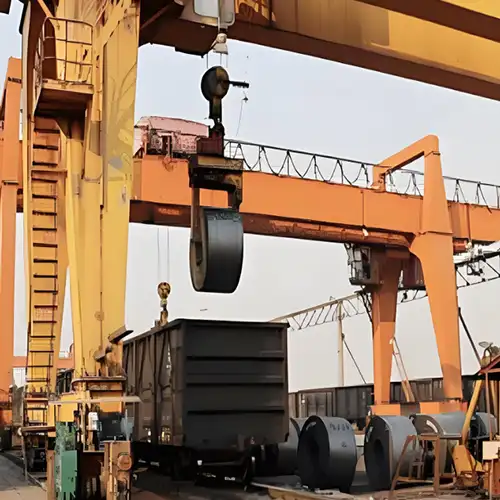
Heavy Load Handling Gantry Crane
Heavy load handling gantry cranes are versatile machines used in shipyards, construction sites, and industrial plants for moving oversized and heavy loads. These cranes are equipped to handle massive machinery, structural components, and other large items that standard cranes might not be able to lift.
- Key Features: Customizable load capacities, large lifting spans, and enhanced stability for extremely heavy loads.
- Applications: Used for lifting heavy industrial equipment, steel structures, and large machinery in industries like construction, manufacturing, and shipbuilding.

Lumber Handling Gantry Crane
In the lumber and timber industry, gantry cranes are specialized for lifting and moving large logs, lumber stacks, and wooden beams. These cranes are built for the weight and dimensions of the materials, ensuring efficient handling in sawmills and lumberyards.
- Key Features: Large lifting capacity, sturdy lifting hooks or clamps for logs, and weather-resistant construction for outdoor operations.
- Applications: Used in sawmills, wood processing plants, and timber yards for moving logs, planks, and beams during processing and storage.

Automotive Parts Handling Gantry Crane
In automotive manufacturing, gantry cranes are specialized to handle large automotive components, such as car chassis, engines, and suspension systems. These cranes help automate the production line, enhancing workflow and reducing labor costs.
- Key Features: Precision lifting systems, ability to handle large components, and integration with automated production systems.
- Applications: Commonly used in automotive assembly lines, engine assembly, and parts manufacturing to lift, position, and transport heavy automotive parts.

Wind Turbine Blade Handling Gantry Crane
These wind turbine blade handling gantry cranes are specifically designed to lift and move large wind turbine blades, which are often over 100 meters long. The crane's extended reach and precision control are crucial for safely positioning the blades for assembly or transport.
- Key Features: Extra-long reach, specialized lifting slings or pads for wind turbine blades, and high stability for handling oversized loads.
- Applications: Used in wind turbine manufacturing, offshore wind farm construction, and transportation hubs for the handling and installation of wind turbine blades.

Container Gantry Crane
While not always categorized as "heavy-duty" in the traditional sense, container gantry cranes are specialized for handling heavy shipping containers in ports and logistics centers. These cranes are optimized for stacking and moving containers weighing several tons.
- Key Features: High lifting capacity, precise movement for container handling, and large reach to stack containers efficiently.
- Applications: Used in container terminals and shipping ports for moving and stacking shipping containers.

Bulk Material Handling Gantry Crane
Bulk material handling gantry cranes with grab bucket are designed to move large quantities of bulk materials, such as sand, gravel, or coal. They are often used in mining operations, ports, and warehouses to load and unload bulk materials quickly and efficiently.
- Key Features: Large capacity buckets or grabs for bulk materials, heavy-duty hoisting mechanisms, and extended reach.
- Applications: Typically used in ports, mining sites, and grain storage facilities for handling bulk materials.
Specialized gantry cranes are essential for industries where heavy and often specialized materials must be handled with precision and safety. From slag handling in steel mills to marble and concrete handling in construction, these cranes are customized to meet the unique demands of each material. Whether for tunnel construction, metal smelting, or stone processing, these cranes provide reliable, efficient, and safe lifting solutions for some of the heaviest and most challenging materials in the world.
Hot Sale Capacity of Heavy Duty Gantry Cranes
Heavy duty gantry cranes are available in various capacities, designed to meet the specific needs of different industrial applications. Ranging from 20 tons to over 500 tons, these cranes feature robust construction and advanced control systems, ensuring optimal performance, safety, and efficiency.
Typical Tonnage:
20-50 Ton Gantry Cranes
These cranes are well-suited for medium-sized industrial tasks, providing versatility and reliability for various applications.
Applications:
- Manufacturing Facilities: Ideal for handling moderate lifting tasks, such as moving components and materials within workshops.
- Construction Sites: Efficient for lifting beams, structural elements, and equipment.
- Assembly Lines: Particularly beneficial in automotive and machinery industries where precise handling of parts is crucial.
Capacity Options:
- 20 Ton Gantry Crane: Commonly used in workshops and warehouses.
- 25 Ton Gantry Crane: Offers enhanced lifting capabilities for slightly heavier tasks.
- 30 Ton Gantry Crane: Ideal for larger loads in industrial settings.
- 40 Ton Gantry Crane: Suitable for heavier applications, ensuring robust performance.
- 50 Ton Gantry Crane: Perfect for demanding environments like steel processing.
Price Estimates:
- 20 Ton Gantry Crane: $70,000 – $143,000
- 30 Ton Gantry Crane: $84,000 – $170,000
- 50 Ton Gantry Crane: $100,000 – $200,000
Key Features:
- Moderate Frequency of Use: Designed for operations that do not require continuous heavy lifting.
- Versatile Load Handling: Capable of managing a variety of loads, from lighter components to moderate-weight materials.
- Regular Operational Hours: Suitable for environments with standard working hours, ensuring consistent performance with minimal downtime.
50-100 Ton Gantry Cranes
These cranes provide increased capacity for heavy-duty tasks while maintaining precision and reliability.
Applications:- Heavy Manufacturing Industries: Efficiently handle large machinery components and materials.
- Large-Scale Construction Projects: Essential for lifting heavy construction materials and structures, such as steel girders and precast elements.
- Shipbuilding and Repair Yards: Facilitate the assembly and maintenance of large vessels, ensuring smooth operational workflows.
- 60 Ton Gantry Crane: Ideal for handling substantial loads in industrial settings.
- 70 Ton Gantry Crane: Offers additional capacity for larger projects and materials.
- 80 Ton Gantry Crane: Designed for significant lifting requirements in demanding environments.
- 100 Ton Gantry Crane: Suitable for extreme heavy-duty applications where maximum performance is essential.
Key Features:
- Robust Construction: Built from high-quality steel to withstand the rigors of heavy use, ensuring long-term durability.
- Safety Features: Integrated mechanisms such as overload protection, emergency stop buttons, and comprehensive monitoring systems to ensure safe operations.
- High Performance: Engineered to deliver efficient lifting capabilities, suitable for tasks requiring frequent use and extended operational hours.
100-500 Ton Gantry Cranes
These cranes are specifically designed for handling the heaviest loads, making them ideal for large-scale industrial applications.
Applications:
- Mega Construction Projects: Essential for lifting and placing massive construction components, such as bridge sections and heavy precast concrete structures.
- Steel Mills and Metal Fabrication Plants: Facilitate the movement of massive steel coils, heavy machinery, and fabricated metal components.
- Aerospace and Defense Industries: Support the assembly and maintenance of large aircraft, spacecraft, and military equipment.
Capacity Options:
- 200 Ton Gantry Crane: Designed for substantial lifting tasks in heavy-duty environments.
- 300 Ton Gantry Crane: Ideal for extreme lifting requirements, providing exceptional reliability and strength.
- 400 Ton Gantry Crane: Suited for demanding applications that require robust performance.
- 500 Ton Gantry Crane: Perfect for the most challenging lifting operations, ensuring safety and efficiency.
Key Features:
- Ultra-Strong and Reinforced Design: Engineered to handle the heaviest loads, with reinforced structures that ensure stability and strength during operation.
- Sophisticated Safety and Automation Systems: Incorporates advanced safety features and automated controls to enhance operational safety and efficiency.
- High Resilience to Wear and Tear: Built to withstand harsh environments and continuous use, ensuring long-term durability and minimal downtime.
Our extensive range of heavy duty gantry cranes, with capacities tailored to specific operational requirements, provides reliable lifting solutions across various industries. From medium to ultra-heavy applications, these cranes are designed to enhance productivity, safety, and efficiency in industrial environments.
Customizing Heavy Duty Gantry Cranes for Optimal Performance
Meeting Industry-Specific Demands
Load Capacity Flexibility
- Customizable to handle load capacities ranging from 20 tons to over 500 tons.
- Ensures cranes can safely lift materials specific to different industries (e.g., large components in manufacturing, heavy materials in construction).
- Optimizes safety and performance, improving operational efficiency.
Span and Height Adjustments
- Cranes can be modified to fit in spaces with limited ceiling height or meet vertical lifting requirements.
- Ideal for tight manufacturing environments or construction sites with high vertical space demands.
- Guarantees effective operation even in restricted operational spaces.
Integrating Advanced Features for Enhanced Functionality
Automated and Smart Control Systems
- Features like remote controls, programmable settings, and warehouse management system integration.
- Increases precision and efficiency by reducing manual input and human error.
- Improves productivity by streamlining operations and minimizing downtime.
Enhanced Safety Mechanisms
- Overload protection, emergency stop systems, and real-time monitoring alerts integrated for safer operation.
- Complies with industry safety standards and reduces the risk of accidents or equipment failure.
- Provides peace of mind by safeguarding both operators and materials during lifting tasks.
Impact of Customization on Operational Efficiency
Optimized Workflow and Reduced Downtime
- Customized cranes help reduce cycle times and improve overall workflow.
- Minimizes downtime by tailoring cranes to specific operational needs, improving task completion speed.
- Enhances productivity by streamlining material handling processes.
Long-Term Cost Efficiency
- Customized cranes are designed for greater reliability, leading to fewer breakdowns and lower maintenance costs.
- Reduces the need for frequent repairs or replacements, extending crane lifespan.
- Offers significant long-term cost savings by improving crane performance and operational continuity.
Why Customization Matters
Enhanced Efficiency
- Tailored cranes meet industry-specific demands, improving performance and safety.
- Customization results in optimized lifting solutions for better productivity.
Increased Longevity and Reliability
- Businesses experience fewer breakdowns and lower maintenance costs, improving crane lifespan.
- Ensures continuous operation with reliable, customized solutions that meet the needs of today and tomorrow.
Safety Considerations
Compliance with Industry Standards
Ensuring compliance with industry standards is crucial for the safe operation of heavy duty gantry cranes. Regulatory bodies, such as the Occupational Safety and Health Administration (OSHA) and the American National Standards Institute (ANSI), set forth guidelines that govern crane design, operation, and maintenance. Adhering to these standards not only protects workers and equipment but also mitigates legal liabilities. Regular audits and adherence to these regulations are essential to maintaining safety in all lifting operations.
Operator Training and Certification
Proper training and certification for crane operators are vital for ensuring safe operations. Operators should undergo rigorous training that covers equipment handling, load management, safety protocols, and emergency procedures. Certification programs often include both theoretical and practical assessments, ensuring that operators are well-prepared to manage the complexities of heavy lifting tasks. Regular refresher courses can help operators stay updated on best practices and any changes in regulations, further enhancing workplace safety.
Regular Inspection and Maintenance Protocols
Implementing regular inspection and maintenance protocols is essential for the longevity and safety of heavy duty gantry cranes. Scheduled inspections should focus on critical components such as hoisting mechanisms, structural integrity, and safety devices. Adhering to a maintenance schedule not only helps identify potential issues before they become serious problems but also ensures that the crane operates at peak performance. Documentation of inspections and maintenance activities is important for compliance and can serve as a valuable resource in case of incidents.
Why Heavy-Duty Gantry Cranes Are a Smart Investment
If you're looking to boost productivity and safety in your business, investing in heavy-duty gantry cranes is the way to go. These cranes are perfect for handling heavy loads, making your operations smoother in areas like manufacturing, construction, and logistics. They're not just about lifting weight—they're about improving efficiency.
Thanks to modern technology and customization options, you can tailor these cranes to fit your exact needs. This means better performance, less downtime, and smoother operations overall. And let's not forget: staying compliant with safety standards and providing proper training keeps your workplace safe. That's why these cranes are a solid long-term investment.
Thinking about upgrading your lifting equipment or expanding your capabilities? Now's the perfect time! Start by evaluating what your business needs. Then, talk to manufacturers or suppliers who can guide you in choosing the right crane. Investing in a customized heavy-duty gantry crane can lead to big improvements in efficiency, safety, and reliability.
Don't wait—reach out to experts, get the advice you need, and take the next step toward optimizing your lifting solutions. The benefits are worth it!
Main Projects
Related Products

Supplied three grab bucket crane kits to Indonesia, enhancing garbage handling efficiency with high load capacity and reliable performance.
Free consultation to Confirm Parameters & Specifications and Get
Latest Crane Price & Crane Rate.
- Types of overhead cranes : _______?
- Optional: Overhead travelling crane, goliath gantry crane,Slewing jib crane, Single girder or double girder crane,small portable crane or kbk crane, etc.
- Capacity of overhead crane: _______?
- Optional: 0.25ton, 0.5 ton, 1 ton, 2 ton, 3ton, 5 ton, 10 ton,15ton, 20ton, 25 ton, 30ton,35ton, up to 550ton, etc.
- Crane span & lifting height : _______?
- Crane travelling length : _____?
- Control of overhead crane:_______?
- Optional: pendant/ remote/cabin control
- Voltage supply of overhead crane:_____?
- Eg,: 380V50/60HZ,3Phase or others,etc.
- Application/usage of crane:_______?
- Eg,: Steel mill, ,injection mold, cement,stone, concrete,granite, general manufacturing, etc.
Just leave a message via the contact form and our hoist and crane engineer will contact you with in 24working hours.
Get In Touch
